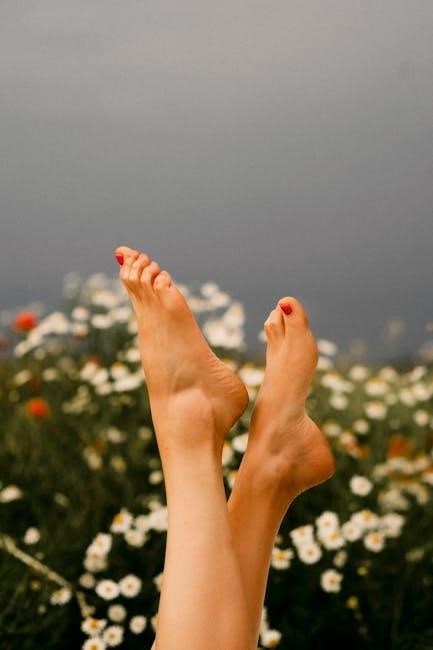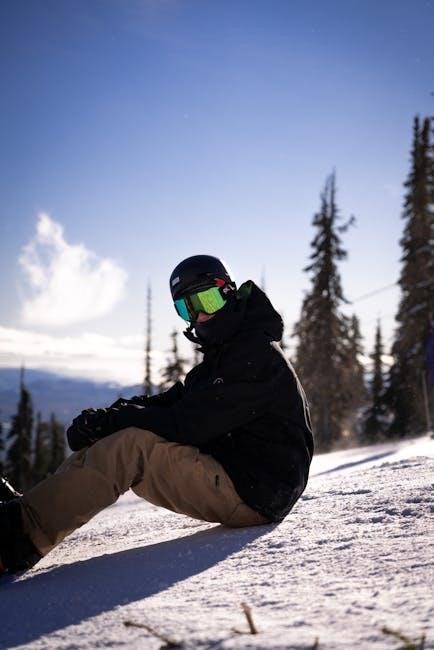A presser foot is an essential sewing machine attachment that stabilizes fabric, ensuring even feeding and consistent stitch quality. It enhances control over various fabrics and sewing techniques.
1.1 What is a Presser Foot?
A presser foot is a sewing machine attachment that plays a crucial role in fabric stabilization during sewing. It is designed to hold the fabric firmly in place, ensuring even feeding and consistent stitch quality. The presser foot works in conjunction with the machine’s feed dogs to guide the fabric smoothly under the needle. Different types of presser feet are available, each tailored for specific fabrics or sewing techniques, such as standard, walking, zigzag, Teflon, and blind hem feet. The presser foot’s primary function is to maintain fabric stability, prevent slippage, and allow for precise control, which is essential for achieving professional-looking results in various sewing projects.
1.2 Importance of Presser Feet in Sewing
Presser feet are indispensable in sewing as they ensure fabric stability and even feeding, which are critical for achieving consistent stitch quality. They prevent fabric slippage and bunching, allowing for precise control, especially when working with delicate or thick materials. The right presser foot can significantly enhance the outcome of sewing projects by maintaining proper tension and alignment. Without a presser foot, managing fabrics like spandex, knits, or heavy textiles would be challenging, leading to uneven stitches and potential machine jamming. Additionally, specialized presser feet enable advanced techniques such as blind hems or zigzag stitching, expanding creative possibilities. Overall, presser feet are essential for improving sewing efficiency, accuracy, and versatility, making them a fundamental tool for both beginners and experienced sewists.
1.3 Brief History of Presser Feet
The concept of presser feet dates back to the early days of sewing machines in the 19th century, when the need for fabric control became evident. Initially, presser feet were simple metal attachments designed to hold fabric in place during stitching. Over time, their design evolved to accommodate various fabrics and sewing techniques. The development of specialized presser feet, such as the walking foot and zigzag foot, marked a significant advancement in sewing technology. These innovations allowed sewists to tackle complex fabrics like stretch materials and heavy textiles with greater ease. Today, presser feet are integral to modern sewing machines, offering a wide range of functionalities tailored to specific tasks. Their evolution reflects the growing diversity of sewing projects and the demand for precision and versatility in fabric handling;
Types of Presser Feet
Presser feet come in various types, each designed for specific sewing tasks, such as standard, walking, zigzag, Teflon, and blind hem feet, catering to diverse fabric and stitching needs.
2.1 Standard Presser Foot
The standard presser foot is the most common and versatile attachment for sewing machines. It is designed for general sewing tasks and works well with straight-stitch sewing. This foot is ideal for fabrics like cotton, linen, and polyester, providing even feeding and consistent stitch quality. Its flat, wide sole ensures stability and prevents fabric from slipping, making it perfect for straight seams and basic repairs. The standard presser foot is usually included with most sewing machines and is a great starting point for beginners. It’s also suitable for lightweight to medium-weight fabrics, offering reliable performance for everyday sewing projects. For more specialized tasks, sewists often switch to other presser feet, but the standard foot remains a cornerstone in any sewing toolkit.
2.2 Walking Presser Foot
The walking presser foot is a specialized attachment designed to handle thick, heavy, or stretchy fabrics with ease. It is particularly useful for sewing through multiple layers of fabric, such as denim, leather, or spandex. This foot features a unique mechanism that moves in synchronization with the sewing machine’s feed dogs, ensuring even fabric feeding and preventing bunching or dragging. The walking foot is ideal for quilting, home decor projects, and sewing stretchy fabrics like knits or activewear. It also excels at managing slippery or delicate materials, providing consistent stitch quality. A must-have for sewists tackling heavy-duty or complex fabrics, the walking presser foot enhances control and precision, making it an essential tool for advanced sewing projects. Its versatility and reliability make it a favorite among both professionals and hobbyists alike.
2.3 Zigzag Presser Foot
The zigzag presser foot is designed to handle fabrics that require flexibility, such as knits and stretch materials. It is particularly useful for sewing projects that involve zigzag stitching, ensuring that the fabric feeds smoothly without slipping. This foot is ideal for creating decorative stitches and embellishments, allowing for precise control over stitch length and width. Its ability to maintain consistent fabric tension makes it a valuable tool for both basic and advanced sewing tasks. Additionally, the zigzag presser foot is well-suited for overcasting stitches, helping to prevent fraying on fabric edges. For optimal results, it’s recommended to adjust the stitch settings according to the fabric type being used. This presser foot is a versatile addition to any sewer’s toolkit, enhancing both functionality and creativity in various projects.
2.4 Teflon Presser Foot
The Teflon presser foot is a specialized attachment designed to work effortlessly with slippery or delicate fabrics, such as silk, nylon, or vinyl. Its non-stick Teflon coating reduces friction, preventing fabric from sticking or dragging under the foot. This makes it ideal for sewing projects involving smooth, synthetic, or coated materials. The Teflon foot is particularly useful for quilting, working with laminated fabrics, or sewing leather, where maintaining fabric stability is crucial. It also excels with thick or heavy fabrics, ensuring smooth feeding and consistent stitch quality. The non-stick surface requires minimal presser foot pressure, allowing the fabric to glide freely. Regular cleaning is recommended to maintain its non-stick properties. For sewers tackling challenging fabrics, the Teflon presser foot is an indispensable tool, offering precision and control in demanding sewing tasks.
2.5 Blind Hem Presser Foot
The blind hem presser foot is a specialized sewing machine attachment designed to create nearly invisible hems, making it ideal for professional-looking finishes. It is commonly used for sewing pants, skirts, and curtains, where a discrete hem is desired. The foot features a guide that helps keep the fabric edge aligned, ensuring the hem is sewn straight and evenly. This foot is particularly useful for thick or heavy fabrics, such as denim or canvas, as it helps maintain consistent stitch quality. The blind hem foot is also versatile, working well for both straight and curved hems. While it is specifically designed for blind hems, it can also be used for general straight-stitch sewing when a standard presser foot is not suitable. For best results, adjust the stitch width and length to match the fabric type and desired seam appearance. Using a twin needle with this foot can also enhance the professional finish of the hem.

How to Use a Presser Foot
Using a presser foot involves attaching it securely, ensuring proper alignment with fabric edges, and adjusting pressure for even feeding. Choose the right foot for your fabric type to achieve consistent stitching and prevent fabric bunching or dragging. Always follow machine-specific guidelines for attachment and use. Properly aligned edges and balanced tension help maintain professional results. Regularly clean and store presser feet to maintain optimal performance. Experimenting with different feet and techniques can expand your sewing capabilities. Always refer to your sewing machine’s manual for specific instructions tailored to your model. Adjusting the presser foot pressure ensures smooth fabric movement, while selecting the right foot enhances stitch quality and fabric handling. This ensures a seamless sewing experience for both beginners and advanced sewists.
3.1 Basic Steps to Attach a Presser Foot
Attaching a presser foot involves a few simple steps. First, lift the presser foot lever to raise the foot. Next, align the presser foot with the machine’s shank, ensuring it snaps securely into place. For most machines, the foot will click when properly attached. Always refer to your sewing machine’s manual for specific instructions, as attachment methods may vary. Once attached, lower the presser foot lever to hold the foot in position. Before sewing, test the foot on scrap fabric to ensure it’s aligned correctly and functioning properly. Proper attachment ensures even fabric feeding and consistent stitching. If using an adapter or shank, make sure it’s compatible with your machine. Never force a presser foot into place, as this could damage the machine or the foot itself. Always handle presser feet gently to avoid bending or breaking them.
3.2 Choosing the Right Presser Foot for Your Fabric
Selecting the appropriate presser foot for your fabric ensures optimal results in sewing. For lightweight fabrics like cotton or silk, a standard presser foot is ideal. Heavy or thick fabrics, such as denim or leather, often require a sturdy foot like the walking presser foot for smooth feeding. Stretch fabrics, such as spandex or knits, benefit from a Teflon or zigzag presser foot to prevent stretching or distortion. Delicate fabrics may need a lightweight or adjustable presser foot to avoid damage. Always consider the fabric’s weight, texture, and stretch when choosing a presser foot. Matching the foot to your fabric ensures even feeding, prevents bunching, and maintains consistent stitch quality. Experiment with different feet to find the best fit for your project. Proper selection enhances both the ease and precision of sewing, making the process more enjoyable and the results more professional.
3.3 Adjusting the Presser Foot Pressure
Properly adjusting the presser foot pressure is crucial for achieving smooth fabric flow and consistent stitching. Too much pressure can cause fabric to drag or bunch, while too little may lead to uneven feeding. Most sewing machines allow pressure adjustment via a dial or knob, typically located near the presser foot. Start with the default setting and test on scrap fabric. For lightweight fabrics like cotton or silk, reduce pressure to prevent dragging. For heavy fabrics such as denim, increase pressure to ensure steady feeding. Stretch fabrics like spandex may require a balanced setting to avoid distortion. Always refer to your machine’s manual for specific instructions, as adjustment mechanisms vary. Experimenting with pressure settings ensures optimal performance for any fabric type, enhancing stitch quality and sewing efficiency. Proper adjustment is key to mastering various sewing techniques and achieving professional results.
3.4 Sewing Techniques with Different Presser Feet
Using the right presser foot can unlock a variety of sewing techniques, allowing for greater precision and creativity. For instance, the walking presser foot excels with thick or layered fabrics, ensuring smooth movement and preventing bunching. The zigzag presser foot is ideal for stretchy materials, maintaining fabric stability during elastic stitching. The Teflon presser foot is perfect for slippery fabrics like silk or vinyl, providing a smooth glide. When working with delicate fabrics, a smaller presser foot helps maintain control without damaging the material. For decorative stitching, specialized feet like the blind hem or satin stitch foot enable intricate patterns and embellishments. Experimenting with different presser feet can enhance your sewing skills, allowing you to tackle a wide range of projects with confidence and precision. Always match the foot to your fabric and technique for the best results.
Maintenance and Troubleshooting
Proper cleaning and storage of presser feet maintain their functionality. Regularly check for debris and damage. Address issues like uneven stitches or fabric bunching promptly to ensure smooth sewing operations.
4.1 Cleaning and Storing Presser Feet
Cleaning and storing presser feet properly ensures longevity and functionality. Use a soft brush to remove lint and debris, and gently wipe with a dry cloth. Avoid harsh chemicals to prevent damage.
Store presser feet in a protective case or pouch to prevent scratching or bending. Label each foot for easy identification. Ensure they are dry before storage to avoid rust or mold.
Regular maintenance and careful storage help maintain the performance of your presser feet, ensuring optimal sewing results for various fabrics and techniques.
4.2 Common Issues with Presser Feet
Common issues with presser feet include improper alignment, which can lead to uneven stitching or fabric dragging. Incorrect pressure settings may cause fabric to bunch up or stretch. Compatibility problems arise when using the wrong foot for specific fabrics or machines, resulting in poor feeding. Additionally, lint and debris buildup on presser feet can interfere with performance, requiring regular cleaning. Physical damage, such as bent or warped feet, can also misalign fabric and disrupt stitching. Addressing these issues promptly ensures smoother sewing and prevents further complications. Proper maintenance and selection of the right presser foot for the task are key to avoiding these common problems.
4.3 How to Fix Uneven Stitch Tension
Uneven stitch tension can be addressed by adjusting the presser foot pressure and ensuring proper fabric feeding. Start by checking the presser foot alignment and ensuring it matches the fabric type. For lightweight fabrics, reduce the pressure to prevent stretching, while heavier fabrics may require increased pressure. Clean the presser foot regularly to remove lint and debris that could interfere with even feeding. If stitches remain uneven, try changing the needle and thread, as poor-quality materials can exacerbate tension issues. Additionally, using a walking presser foot for thick or layered fabrics can help maintain consistent tension. Finally, consult your machine’s manual for guidance on adjusting internal tension settings or seek professional servicing if the problem persists.
4.4 Preventing Fabric from Bunching Up
Fabric bunching can be prevented by using the right presser foot and maintaining proper fabric alignment. Start by ensuring the fabric edge aligns with the presser foot guide. For slippery or delicate fabrics, use a Teflon or walking presser foot to enhance grip and prevent slippage. Adjusting the stitch length and width can also help maintain even fabric flow. Lightly pinning the fabric layers together before sewing can reduce shifting and bunching. Additionally, using a higher presser foot pressure setting for thick fabrics and lowering it for lightweight materials can improve control. Always guide the fabric smoothly and avoid pulling or pushing it forcefully, as this can cause uneven feeding. For persistent issues, consider using stabilizing materials like interfacing or spray starch to add rigidity to the fabric.
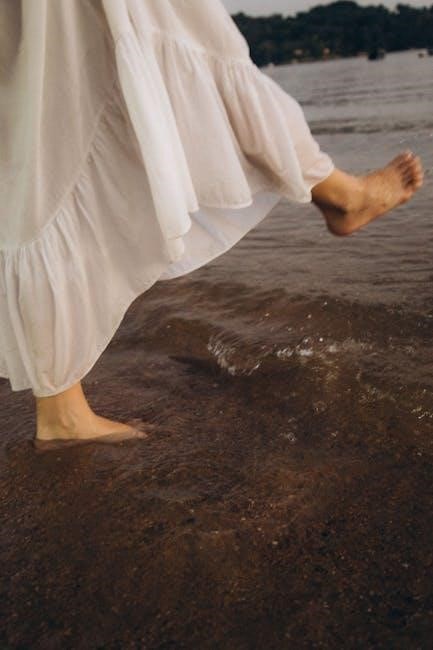
Advanced Sewing Projects with Presser Feet
Advanced sewing projects, like working with spandex or thick fabrics, benefit from specialized presser feet. These tools enable smooth stitching, decorative embellishments, and precise control over challenging materials for professional results.
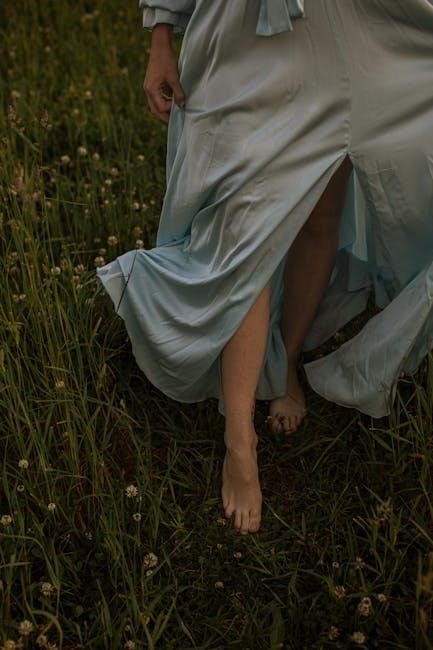
5.1 Sewing Spandex and Stretch Fabrics
Sewing spandex and stretch fabrics requires the right presser foot to maintain fabric stability and prevent stretching or distortion. The walking presser foot is ideal for these materials, as it provides an extra set of feed dogs, ensuring smooth fabric movement and consistent stitches. For delicate knits, a Teflon presser foot reduces friction, allowing the fabric to glide effortlessly. When working with spandex, it’s crucial to use a stretch stitch or zigzag stitch to allow for recovery. Always test your machine settings on a scrap piece to ensure proper tension and stitch length. Using the correct presser foot and adjusting your machine settings can make sewing stretch fabrics easier and more professional-looking. This ensures your projects, like activewear or stretchy accessories, turn out flawless and durable.
5.2 Working with Delicate or Thick Fabrics
When sewing delicate fabrics like silk, chiffon, or voile, or thick fabrics such as denim or upholstery, choosing the right presser foot is essential. For delicate fabrics, a Teflon or satin presser foot is ideal, as it reduces friction and prevents fabric from tearing or puckering. Thick fabrics, on the other hand, often require a heavy-duty presser foot or a high-shank foot for better stability and control. Adjusting the presser foot pressure according to fabric thickness ensures even feeding and prevents fabric bunching. For delicate fabrics, lowering the tension and using a sharp needle can also improve results. Always test settings on scrap fabric before starting your project to ensure optimal performance and avoid damage. This approach ensures your delicate or thick fabrics are handled with care, resulting in professional-looking seams and stitches.
5.3 Creating Decorative Stitches and Embellishments
Decorative stitches and embellishments can elevate your sewing projects, and the right presser foot makes this process effortless. For intricate designs, a zigzag or specialized decorative stitch foot is ideal, as it allows smooth fabric movement and precise stitch alignment. Experiment with varying stitch lengths and widths to achieve unique patterns. When working with embroidery or appliqué, a clear sole presser foot provides visibility, ensuring accurate placement of designs. Maintain consistent fabric tension to prevent puckering or misalignment. Additionally, using a twin needle presser foot can create dimensional effects, such as parallel lines or decorative hems. Always test stitches on scrap fabric to fine-tune settings before applying them to your final project. With the right presser foot and technique, you can add professional-looking embellishments to garments, home decor, or accessories, making your creations truly stand out.
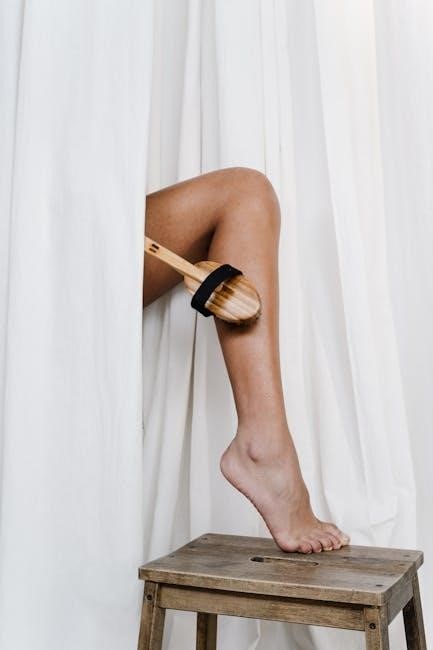
Presser Foot Accessories
Presser foot accessories, such as shanks, adapters, and optional attachments, enhance functionality and compatibility. They ensure proper fitment with various sewing machines, optimizing performance for specialized sewing tasks and projects.
6.1 Presser Foot Shank and Adapters
Presser foot shanks and adapters are essential connectors that attach presser feet to sewing machines. They ensure compatibility and proper alignment, allowing smooth fabric feeding. Shanks come in various types, such as high, low, or slanted, to fit different machine models. Adapters are used when the presser foot has a different attachment system than the machine, enabling universal use. Proper fitment is crucial for optimal performance, as incorrect shanks or adapters can lead to poor stitch quality or machine damage. Always choose the correct shank size and type for your specific machine to ensure secure attachment and precise stitching. These accessories are indispensable for sewists working on intricate or heavy-duty projects, enhancing the versatility of their sewing machines. By using the right shank or adapter, you can unlock the full potential of your presser feet and achieve professional results.
6.2 Presser Foot Sets for Specific Sewing Machines
Presser foot sets are tailored to specific sewing machine models, ensuring compatibility and optimal performance. These sets typically include multiple feet designed for various tasks, such as zigzag, straight stitching, or specialized techniques. They are crafted to match the machine’s feed system and pressure requirements, ensuring smooth fabric handling and consistent stitch quality. Many sets are designed for popular machine brands, offering users a convenient way to expand their sewing capabilities. For example, a set might include a walking foot for heavy fabrics, a Teflon foot for delicate materials, and a blind hem foot for precise edge work. These sets are often bundled with a shank or adapter to ensure proper attachment. By using machine-specific presser foot sets, sewists can maximize their machine’s functionality and achieve professional-grade results across a wide range of projects.
6.3 Optional Attachments for Enhanced Functionality
Optional attachments for presser feet can significantly enhance sewing machine functionality, offering specialized tools for unique tasks. These attachments are designed to work seamlessly with specific presser feet, expanding their capabilities. For instance, edge guides and seam guides help maintain precise alignment, ideal for straight stitching or quilting. Quilting bars and even-feed attachments are perfect for managing thick fabrics or multiple layers. Some attachments, like rufflers or gatherers, add decorative elements or texture to fabrics. Others, such as free-motion embroidery feet, enable intricate stitching designs. These optional enhancements allow sewists to tackle a broader range of projects with greater ease and precision. By investing in these attachments, users can unlock their machine’s full potential, transforming it into a versatile tool for both practical and creative sewing endeavors. They are especially valuable for professionals and hobbyists seeking to expand their sewing repertoire.
